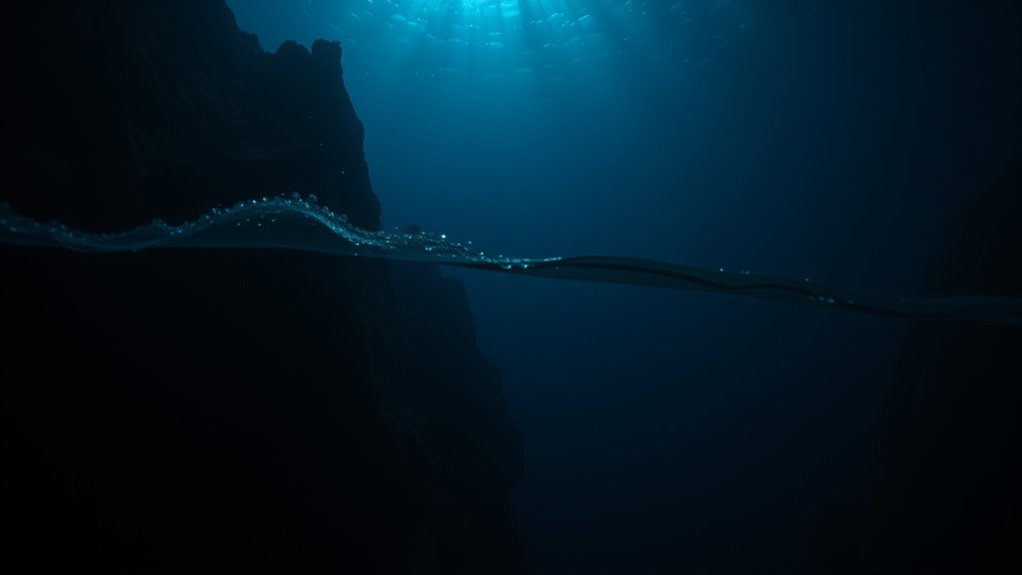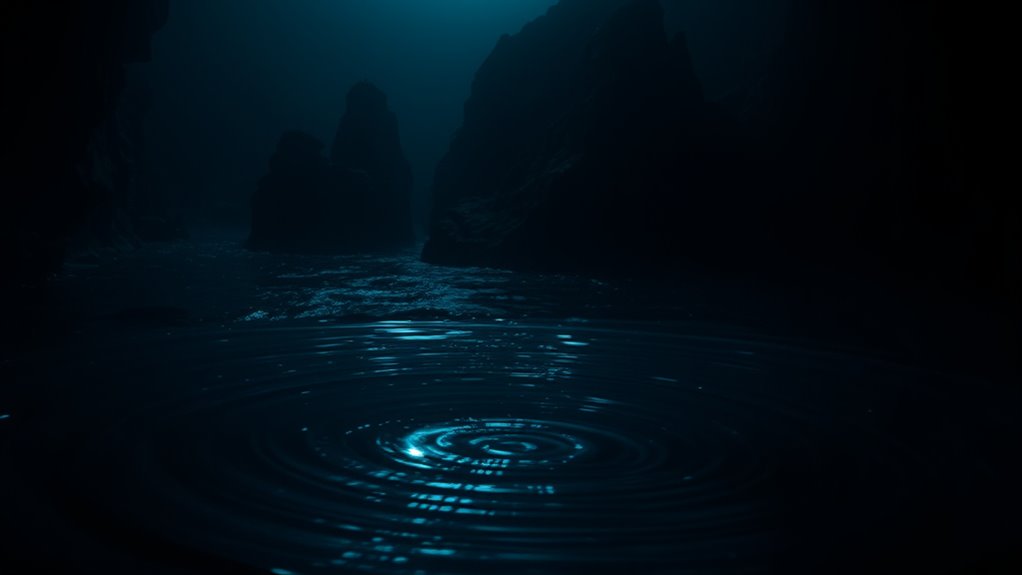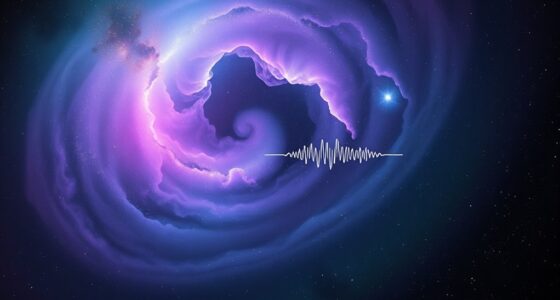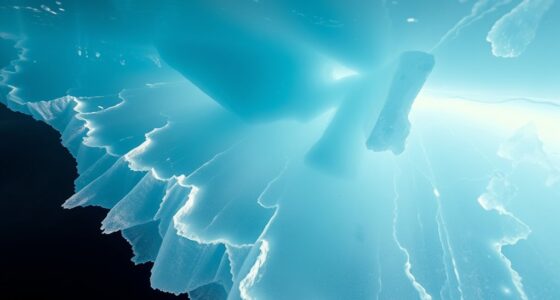The mysterious booms in the Mariana Trench come from a mix of seismic activity and biological sounds from deep-sea creatures. Earthquakes and seabed shifts produce powerful, low-frequency noises that travel great distances. Biological life, like bioluminescent animals, adds faint sounds as they move. The trench’s shape amplifies and distorts these noises, making their origins hard to pinpoint. If you look further into this, you’ll uncover even more fascinating insights about this hidden underwater world.
Key Takeaways
- Mysterious booming sounds in the Mariana Trench are linked to seismic activity and underwater earthquakes.
- These sounds are amplified and distorted by the trench’s unique topography, complicating their origin.
- Biological sources like bioluminescent creatures contribute faint sounds but are less likely to cause loud booms.
- The complex interaction of geological and biological factors creates an unpredictable and mysterious soundscape.
- Ongoing research aims to distinguish seismic, biological, or combined sources of these unexplained underwater booms.

Deep beneath the ocean’s surface, in the depths of the Mariana Trench, strange and unexplained sounds have recently captured scientists’ attention. These mysterious noises seem to echo through the abyss, raising questions about what’s causing them. As you imagine the dark, crushing depths, it’s easy to picture bioluminescent creatures flickering faintly in the darkness, their glowing bodies sometimes producing faint sounds as they move. Many researchers believe that some of these bioluminescent animals, in their silent dance, might generate subtle noises that contribute to the underwater soundscape. However, these sounds are often much louder and more persistent than what natural bioluminescence alone could produce.
Bioluminescent creatures may produce faint sounds, but the ocean’s mysterious noises are far louder and more complex.
One of the leading theories points to underwater earthquakes, which are common in seismic zones like the Mariana Trench. These seismic events generate low-frequency vibrations that can ripple through the ocean floor and water column. When an earthquake occurs, it can cause the seabed to shift suddenly, releasing powerful acoustic waves into the surrounding water. These waves travel vast distances, sometimes being detected by underwater microphones called hydrophones. What makes these seismic sounds particularly intriguing is their pattern and intensity, which don’t always match typical earthquake signatures. Instead, they sometimes resemble booming or roaring noises, echoing through the trench with a startling force. Additionally, the movement of bioluminescent creatures might be triggered or influenced by seismic activity, creating a complex interplay of biological and geological sounds. Researchers have also observed that the ocean’s unique topography can amplify and distort these sounds, making it even more challenging to interpret their origin. Recent studies suggest that acoustic amplification caused by the trench’s unusual shape may further distort the sounds we hear. Furthermore, some scientists propose that unknown biological sources could be contributing to these mysterious noises, adding another layer to the underwater soundscape. The interactions between geology and biology are believed to be a key factor in shaping the sounds detected in this region.
As you consider this, you realize that these sounds might be a combination of multiple factors. For instance, underwater earthquakes could trigger the movement of bioluminescent creatures hiding in the darkness, causing them to produce sounds that add to the overall noise. This overlapping of seismic activity and biological responses creates a complex acoustic environment that’s hard for scientists to interpret. Additionally, some of the sounds recorded appear to be sporadic and unpredictable, further complicating efforts to pinpoint their origin. Researchers are still trying to understand whether these sounds are direct signals from seismic activity, biological phenomena, or a mix of both.
While the precise cause remains a mystery, what’s clear is that these unexplained booms and sounds highlight just how little we understand about the deep ocean. The Mariana Trench remains one of Earth’s most enigmatic regions—full of strange creatures, seismic events, and now, loud, mysterious noises. As scientists continue to study these sounds, you can’t help but feel a sense of wonder about what secrets lie hidden beneath the waves, waiting to be uncovered.
Frequently Asked Questions
Could These Sounds Be Caused by Underwater Volcanic Activity?
You might wonder if underwater volcanic activity causes these sounds. Tectonic shifts and submarine eruptions can produce powerful vibrations, generating loud noises beneath the ocean. When magma moves or erupts, it disturbs the water, creating deep, resonant booms. So, yes, these mysterious sounds could be linked to volcanic activity, especially in areas with active tectonic plates, like the Mariana Trench, where such processes are common.
Are There Any Known Marine Creatures Responsible for These Noises?
Could marine creatures be causing these mysterious noises? You might think of bioluminescent organisms or whale vocalizations, but the deep trench’s dark depths host creatures with sounds that are still largely a mystery. While whales produce loud, patterned calls, their voices don’t match the recorded booming sounds. So, you probably won’t find a simple marine creature responsible—these sounds remain a strange, fascinating feature of the deep.
Have Similar Sounds Been Recorded in Other Deep-Sea Locations?
You might wonder if similar sounds have been recorded elsewhere in deep-sea acoustics. Marine sound recordings from various deep-sea locations show that unique, mysterious noises often occur, sometimes resembling those from the Mariana Trench. These sounds could be linked to natural phenomena or marine life. So, yes, deep-sea acoustics reveal that such unexplained noises are not exclusive to one area, sparking curiosity about their true origins.
What Equipment Is Used to Detect and Analyze These Sounds?
Think of deep-sea sound detection like setting a net in a stormy sea. You use hydrophone arrays, which are multiple underwater microphones, to capture the mysterious sounds. Sonar technology then helps analyze these signals, revealing their source and nature. This combination allows scientists to listen to the ocean’s secrets, much like deciphering messages from a hidden world beneath the waves.
Could Human Activities Influence or Create These Mysterious Underwater Booms?
You might wonder if human activities cause these mysterious underwater booms. It’s possible, as marine noise pollution from ships, drilling, and sonar interference can create sounds that mimic natural phenomena. When these activities occur near sensitive areas like the Mariana Trench, they could influence or even generate the mysterious sounds recorded. Reducing marine noise pollution and regulating sonar use can help minimize human impact on these deep-sea environments.
Conclusion
So, next time you hear about strange sounds from the depths, ask yourself—what truly lies beneath the surface? The Mariana Trench’s unexplained booms remind us how little we really know about our planet’s deepest corners. Could these mysterious noises be nature’s secrets waiting to be uncovered or something more? As scientists continue their quest, one thing’s certain: the ocean still holds countless surprises, urging you to wonder what mysteries remain hidden beneath its waves.









